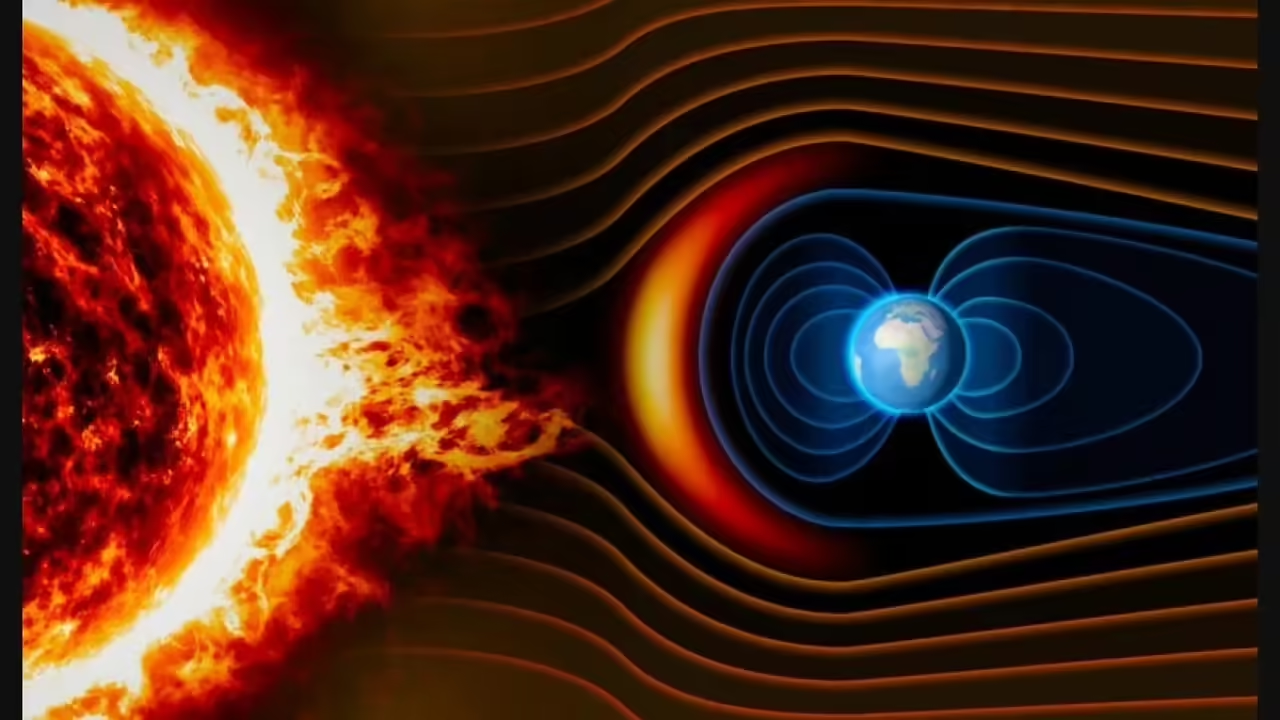
The Sun is the most important star for life on Earth, but it is also a source of phenomena that can affect our planet and the entire solar system. One of these phenomena is the change of polarity of the solar magnetic field, which occurs approximately every 11 years.
The solar magnetic field is generated by the movement of plasma in the interior of the Sun, and manifests itself on the surface as sunspots and solar flares. The latter release large amounts of energy and particles that travel through space and interact with the Earth’s magnetic field, producing effects such as the northern and southern lights.
The change of polarity of the solar magnetic field means that magnetic north becomes magnetic south, and vice versa. This process occurs gradually and asymmetrically, i.e. the two solar hemispheres do not change at the same time or in the same way. According to data from the Wilcox Solar Observatory at Stanford University (USA), the northern hemisphere already changed its polarity at the end of August 2013, and the southern hemisphere will do so shortly.
This change has consequences for the entire solar system, as it modifies the shape and extent of the heliosphere, which is the region of space where the solar magnetic field dominates the interstellar magnetic field. The heliosphere acts as a shield that protects the solar system from cosmic rays, which are high-energy particles from external sources such as supernovae.
Scientists are alert to this phenomenon, as it can have effects on power grids, communication systems and artificial satellites orbiting the Earth. However, there is no cause for alarm, as this is a natural and periodic process that the Sun has experienced many times throughout its history.
What is the solar magnetic field and why is it about to change?
The solar magnetic field is a natural phenomenon that occurs due to the electromagnetic energy generated by the Sun. This magnetic field is very important because, among other things, it is responsible for protecting the Earth from harmful cosmic radiation.
The solar magnetic field originates in the outer layer of the Sun, called the solar corona. The solar corona is the outermost layer of the Sun’s atmosphere and is extremely hot, with temperatures reaching 2 million degrees Celsius. The magnetic energy generated by the plasma dynamics in the solar corona is what produces the solar magnetic field.
The solar magnetic field changes constantly over time, in a cycle that lasts approximately 11 years. During this cycle, the polarity of the solar magnetic field reverses, that is, it changes from north to south and vice versa. When the polarity of the solar magnetic field reverses, an event known as solar magnetic field reversal occurs.
A solar magnetic field reversal is expected to occur in the next few years, which could have important consequences for the Earth. During solar magnetic field reversal, the magnetic field weakens and becomes more chaotic, increasing the risk of solar storms and other space weather-related events.
Solar storms can cause disruptions in satellite communication, navigation systems and other electronic systems on Earth. They can also cause power outages, damage electronic equipment, and affect human health.
In addition, solar magnetic field reversals could have an impact on the Earth’s climate. Some studies suggest that solar magnetic field reversals are related to changes in global climate, including periods of cooling and warming.
As the solar magnetic field reversal approaches, scientists are studying the phenomenon in more detail to better understand its effects and how we can prepare for them. NASA and other space agencies are constantly monitoring the Sun and its magnetic field in order to detect any activity that may indicate the arrival of a solar storm or other space weather-related events.
How will the changing solar magnetic field affect our technology and electrical systems?
The change in the solar magnetic field can have a significant impact on our technology and electrical systems due to solar storms that can occur during the solar magnetic field reversal. These solar storms are bursts of electromagnetic radiation and particles that are released by the Sun and can affect the Earth.
When a solar storm hits the Earth, it can cause interference in radio and GPS signals, as well as in satellite communications systems. In addition, it can cause overloads in electrical grids and damage transformers and other electrical equipment, which can lead to blackouts and power outages.
Solar storms can also have an impact on human health, especially astronauts and passengers on commercial flights traveling through the polar regions. During a solar storm, high levels of radiation can be produced that can increase the risk of cancer and other health problems.
To mitigate the effects of solar storms, scientists are developing monitoring and early warning systems to detect solar storms and predict their effects. Electric utilities are also taking steps to protect their equipment and power grids, including the installation of surge protection devices.
In addition, governments and international organizations are working together to develop preparedness and response strategies in the event of a major solar storm. These strategies include contingency plans and emergency protocols to ensure the continuity of critical services during a solar storm.
When will the solar magnetic field change occur and how long will it last?
Currently, the next solar magnetic field change is expected to occur sometime between 2023 and 2026. However, the exact prediction of when the solar magnetic field change will occur is not an exact science and there may be variations in the expected date.
Once the solar magnetic field reversal process begins, it may take several months or even years before it is complete. During this time, the Sun’s magnetic field can become more complex and chaotic, which can increase solar activity and the likelihood of solar storms.
What steps are being taken to prepare for the changing solar magnetic field?
To prepare for the upcoming change in the solar magnetic field, which is expected to occur in 2025, several measures are being taken at the scientific, technological and societal levels. Some of these measures are:
– The constant monitoring of solar activity and the state of the Earth’s magnetic field, through space and ground-based observatories, such as NASA’s Solar Dynamics Observatory (SDO) and the European Space Agency’s (ESA) Swarm.
– The development of protection and mitigation systems for satellites, power grids, telecommunications and air and maritime navigation that can withstand or minimize the effects of solar storms and variations in the Earth’s magnetic field.
– The dissemination of information and recommendations to the population on the possible risks and benefits of the change in the solar magnetic field, as well as the prevention and safety measures to be adopted in the event of an emergency.
– International cooperation between countries and organizations involved in the research and management of solar magnetic field change, to share data, resources and experiences, and to coordinate joint actions.
The mysteries of the solar magnetic field: what we know and what we still don’t understand
The Sun is the closest star to us and the largest source of energy in the solar system. However, it still holds many mysteries that defy science, especially regarding its magnetic field. The solar magnetic field is responsible for explosive phenomena that occur in the outer layers of the solar atmosphere, such as flares and coronal mass ejections, which can affect the Earth and the rest of the planets. It is also believed to play an important role in the heating of the solar corona, which reaches temperatures of millions of degrees, much higher than those on the visible surface of the Sun.
To better understand how energy is generated and transferred between different regions of the solar atmosphere, it is necessary to measure the magnetic field from the photosphere, the outermost layer of the Sun that we can see, to the base of the corona, where the transition to a very hot, thin plasma occurs. However, this task is not easy, as it requires observing the polarization of the Sun’s ultraviolet light, which can only be done from space and with very sophisticated instruments.
An example of these instruments is the CLASP2 experiment, created by an international consortium with Spanish participation, which studies the Sun’s magnetism using telescopes launched into space with suborbital rockets. On April 11, 2019, CLASP2 made observations of an active region of the solar disk for two and a half minutes, while the Japanese space telescope Hinode pointed at the same area. Thanks to the analysis of these data, the researchers have managed to produce, for the first time, a map of the solar magnetic field from the photosphere to the chromosphere, an intermediate layer between the corona and the photosphere.
The results of the study, published in Science Advances, show that the magnetic field in the chromosphere is more complex and variable than in the photosphere, and that there is a good correlation between the magnetic and thermal structures in both layers. These findings are of great scientific interest, as they will help to decipher the magnetic coupling between the different regions of the solar atmosphere and to advance our knowledge of the physical processes occurring in the Sun.
What research is being done to better understand the solar magnetic field and its change?
The solar magnetic field is one of the main sources of activity and variability on the Sun. Its study is fundamental to understanding the physical processes occurring in the solar atmosphere and their influence on space weather. To better understand the solar magnetic field and its change, several investigations are being carried out from different perspectives and with different instruments. Some of these investigations are:
– The analysis of observations from the Solar Dynamics Observatory (SDO) space telescope, which provides high-resolution images and spectropolarimetry of the entire solar disk at various wavelengths.
– The development of numerical models that simulate the evolution of the solar magnetic field from the interior to the corona, taking into account the effects of differential rotation, convection, emergence and recombination of magnetic fields.
– Conducting laboratory experiments that reproduce the physical conditions of the solar atmosphere and allow the study of instability, turbulence and magnetic reconnection phenomena that affect the solar magnetic field.
– Participation in space missions such as the Solar Orbiter, to be launched in 2020, which will orbit the Sun at a minimum distance of 0.28 astronomical units, providing unprecedented observations of the solar magnetic field from different angles and heights.







